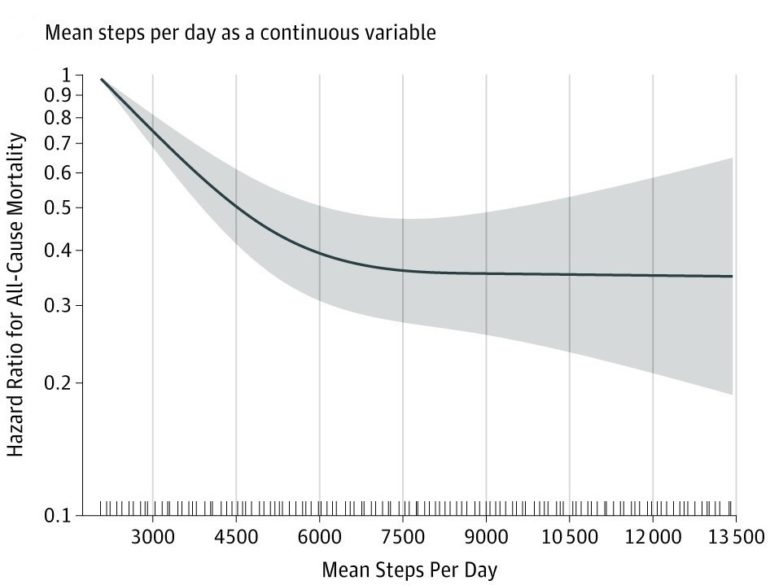Sedentary lifestyles are on the rise. More and more people are sitting down on the commute, sitting down at work and sitting down for leisure.
8 December 2020
"When it comes to health and well-being, regular exercise is about as close to a magic potion as you can get."
Sedentary lifestyles are on the rise. More and more people are sitting down on the commute1, sitting down at work and sitting down for leisure.From 1950 to 2000 the proportion of the US workforce in low physical activity jobs doubled, the proportion of people commuting in cars increased by around 50% and the average number of hours per day spent watching television nearly doubled and these trends look set to continue (if we include streaming services in with television).
Physical activity and longevity
It may not be surprising that higher physical activity is associated with longer lives. A 2012 meta-study concluded that the probability of dying in the following year (all-cause mortality) is around a third lower in physically active rather than inactive individuals and that increased physical activity reduces the occurrence of many major mortality risk factors such as diabetes, cancer, heart disease and stroke.
A 2020 study of nearly 100,000 participants (average age 62) of the UK biobank made use of the popularity of wearable devices to investigate the effect of “physical activity energy expenditure” on all-cause mortality. After controlling for lifestyle, health and demographics, higher levels of energy expenditure were significantly associated with lower mortality rates. Mortality rates were even lower when the same level of energy expenditure was achieved through higher intensity activity.
A 2018 study of over 25,000 individuals (aged 50+) from the US Health and Retirement Study (HRS) and the English Longitudinal Study of Ageing (ELSA) looked at the effects of four key mortality risk factors: alcohol consumption, smoking, physical inactivity and obesity. From this sample, physical inactivity was the most common risk factor in England and the US. All risk factors were strongly associated with shorter life expectancies; obesity and physical inactivity led to the greatest reduction in healthy life expectancy (years expected to live free of chronic disease).
Every little bit helps
Starting and maintaining an exercise regime can feel daunting to many people, but it is important to know that even small increases in physical activity can have significant effects on health and longevity.
A study in Sweden followed nearly 9,000 people aged between 62 and 90 over an 11-year period, 2004-2015. After controlling for lifestyle, health and demographics, being physically active just two or three times a week was associated to a 28% higher likelihood of surviving the study period. This positive effect of even low levels of physical activity was called out by the researchers to be considered in the development of public health programs.
In a 2019 US study using data from the Women’s Health Study, the link between daily step count and all-cause mortality was investigated in over 16,000 women (mean age 72). After controlling for various lifestyle, demographic and health factors, a step count of around 4,400 per day was shown to be significantly related to lower mortality rates, compared to around 2,700 per day. Above 4,400 steps per day, there were diminishing returns for extra steps, with the gains levelling out at around 7,500 steps per day (see chart below). In contrast to the 2020 study mentioned in the previous section, here stepping intensity was not clearly related to lower mortality rates after controlling for number of steps.

Source: Min Lee et al, Association of Step Volume and Intensity With All-Cause Mortality in Older Women, JAMA Intern Med. 2019;179(8):1105-1112
There has been a big focus on the aspiration of completing 10,000 steps per day. Given the studies discussed above, this may be an unhelpful target. There seem to be significant benefits from more modest levels of activity and setting too high a target could put people off trying at all.
It’s never too late
In a 2019 US study of over 300,000 participants, after controlling for lifestyle, demographics and health, the relationship between different lifetime profiles of “Leisure Time Physical Activity” and mortality rates was investigated. Higher levels of physical activity later in life were significantly associated to lower levels of all-cause mortality rates, regardless of whether the individuals had maintained these levels from younger ages or had increased activity later in life.
It seems it’s never too late to start exercising. There are significant gains to be made by sedentary adults becoming more active, and people who were active when they were younger are likely to benefit from trying to maintain those levels as they grow older.
What does this mean for pension plans and insurers?
The relatively recent shift to more sedentary lifestyles and the links between physical inactivity and increased mortality and morbidity may contribute to a paring back of future longevity improvements. However, various public health initiatives have been introduced around the world to encourage people to be more active (e.g., in the US, the UK and Canada) and health insurers are now encouraging more active lifestyles through gamification or financial incentives using wearable technology. Only time will tell whether these efforts will be enough to counterbalance the effects of increased sedentism. In addition, it is yet unclear what effect the recent pandemic-driven move to home working will have on physical activity. Some may see activity levels reduce as they move around less, others may find more time to exercise without the daily commute. Pension plans and insurers will need to monitor the emerging data to see how these competing effects ultimately begin to manifest across society.
Notes:
1. when able to commute
VitaMins Health: Physical activity – are you sitting comfortably?
Download the full article.



